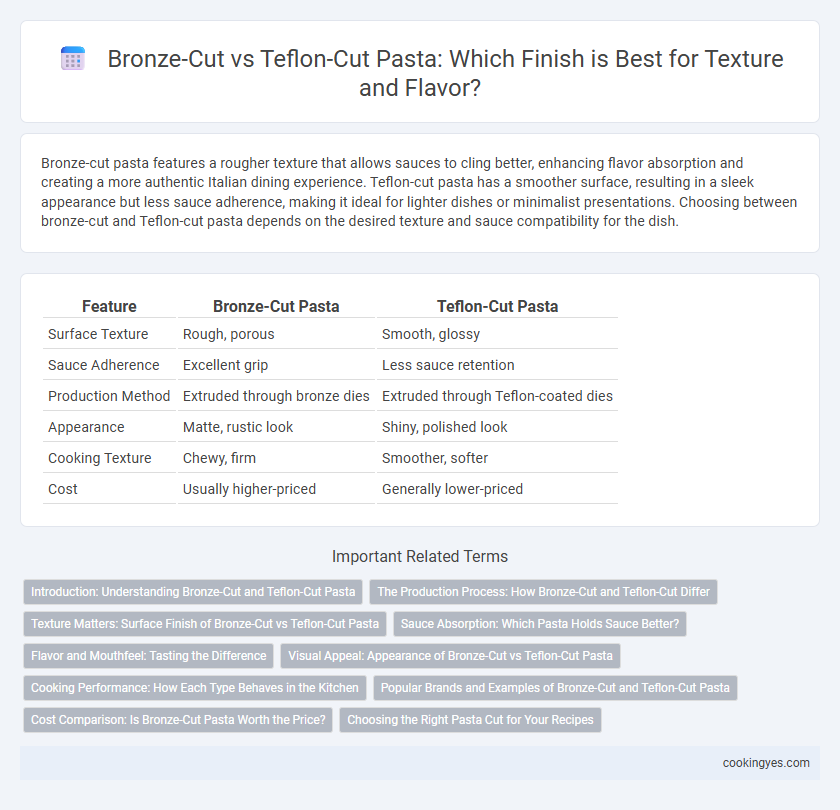Bronze-cut pasta features a rougher texture that allows sauces to cling better, enhancing flavor absorption and creating a more authentic Italian dining experience. Teflon-cut pasta has a smoother surface, resulting in a sleek appearance but less sauce adherence, making it ideal for lighter dishes or minimalist presentations. Choosing between bronze-cut and Teflon-cut pasta depends on the desired texture and sauce compatibility for the dish.
Table of Comparison
| Feature | Bronze-Cut Pasta | Teflon-Cut Pasta |
|---|---|---|
| Surface Texture | Rough, porous | Smooth, glossy |
| Sauce Adherence | Excellent grip | Less sauce retention |
| Production Method | Extruded through bronze dies | Extruded through Teflon-coated dies |
| Appearance | Matte, rustic look | Shiny, polished look |
| Cooking Texture | Chewy, firm | Smoother, softer |
| Cost | Usually higher-priced | Generally lower-priced |
Introduction: Understanding Bronze-Cut and Teflon-Cut Pasta
Bronze-cut pasta features a rough, porous surface created by shaping dough through bronze dies, enhancing sauce adherence for richer flavor. Teflon-cut pasta, produced using non-stick Teflon dies, results in a smoother, shinier finish that cooks more uniformly but may hold sauce less effectively. Choosing between bronze and Teflon-cut impacts texture and sauce absorption, influencing the overall pasta dish quality.
The Production Process: How Bronze-Cut and Teflon-Cut Differ
Bronze-cut pasta is produced by extruding dough through bronze dies, which create a rough, porous surface that helps sauce adhere better, enhancing flavor absorption. In contrast, teflon-cut pasta uses non-stick Teflon-coated dies, resulting in a smoother finish that reduces sauce retention and offers a more refined texture. The choice between bronze and teflon dies significantly influences the pasta's texture, sauce adherence, and overall culinary experience.
Texture Matters: Surface Finish of Bronze-Cut vs Teflon-Cut Pasta
Bronze-cut pasta features a rough, porous surface that better absorbs sauces, enhancing flavor and texture with a traditional, artisanal finish. Teflon-cut pasta has a smooth, glossy finish that results in a slippery texture, causing sauces to slide off and reducing overall flavor adherence. The texture difference significantly impacts the culinary experience, making bronze-cut pasta preferred for rich, thick sauces.
Sauce Absorption: Which Pasta Holds Sauce Better?
Bronze-cut pasta features a rougher, porous surface that enhances sauce adhesion and absorption, making it ideal for capturing rich, chunky sauces. Teflon-cut pasta, with its smooth and shiny finish, tends to repel sauce, resulting in less cling and a slipperier texture. For recipes requiring robust sauce coverage, bronze-cut pasta consistently delivers superior flavor integration and mouthfeel.
Flavor and Mouthfeel: Tasting the Difference
Bronze-cut pasta features a rough, porous surface that allows sauces to cling better, enhancing flavor absorption and delivering a more robust mouthfeel. In contrast, Teflon-cut pasta has a smoother finish, resulting in a silkier texture but less sauce adherence, often leading to a less intense flavor experience. The distinct surface textures directly influence the tasting profile, with bronze-cut pasta typically prized for its authentic, hearty bite and enhanced sauce integration.
Visual Appeal: Appearance of Bronze-Cut vs Teflon-Cut Pasta
Bronze-cut pasta features a rough, porous surface that enhances sauce adherence and creates a rustic, artisanal appearance, making it visually appealing in traditional Italian dishes. Teflon-cut pasta has a smooth, glossy finish that reflects light, offering a sleek and uniform look often favored in modern culinary presentations. The bronze-cut texture highlights the handmade feel, whereas the Teflon-cut's polished surface contributes to a refined and elegant plate aesthetic.
Cooking Performance: How Each Type Behaves in the Kitchen
Bronze-cut pasta features a rougher surface texture that allows sauce to cling effectively, enhancing flavor absorption and resulting in a more robust mouthfeel. Teflon-cut pasta produces a smoother finish, leading to quicker cooking times but a less adhesive surface that may cause sauces to slide off. Chefs often prefer bronze-cut pasta for traditional dishes due to its superior sauce retention and al dente texture during cooking performance.
Popular Brands and Examples of Bronze-Cut and Teflon-Cut Pasta
Bronze-cut pasta, known for its rough texture that holds sauces effectively, is exemplified by popular brands such as De Cecco and Rustichella d'Abruzzo, which use traditional bronze dies to create a porous surface. Teflon-cut pasta, featuring a smooth and glossy finish due to modern non-stick dies, can be found in brands like Barilla and Garofalo, offering a sleek appearance and quicker cooking times. These distinct cutting methods influence both the pasta's texture and sauce adherence, with bronze-cut often preferred for artisanal dishes and Teflon-cut favored in mass-produced varieties.
Cost Comparison: Is Bronze-Cut Pasta Worth the Price?
Bronze-cut pasta, characterized by a rougher texture that better holds sauce, typically commands a higher price due to the cost-intensive bronze die manufacturing process. Teflon-cut pasta, produced with cheaper Teflon-coated dies, offers a smoother finish and more affordable pricing, making it a popular choice for budget-conscious consumers. Evaluating whether bronze-cut pasta is worth the extra cost depends on the preference for superior sauce adherence and artisanal texture versus cost-efficiency and mass production convenience.
Choosing the Right Pasta Cut for Your Recipes
Bronze-cut pasta features a rough, porous surface that holds sauces exceptionally well, making it ideal for hearty, chunky dishes like ragu or pesto. Teflon-cut pasta, produced with non-stick dies, has a smoother texture that suits delicate, light sauces such as olive oil or butter-based recipes. Selecting the right pasta cut enhances sauce adherence and complements the flavor profile of your dish, ensuring optimal taste and texture.
Bronze-cut vs Teflon-cut for pasta finish Infographic

 cookingyes.com
cookingyes.com